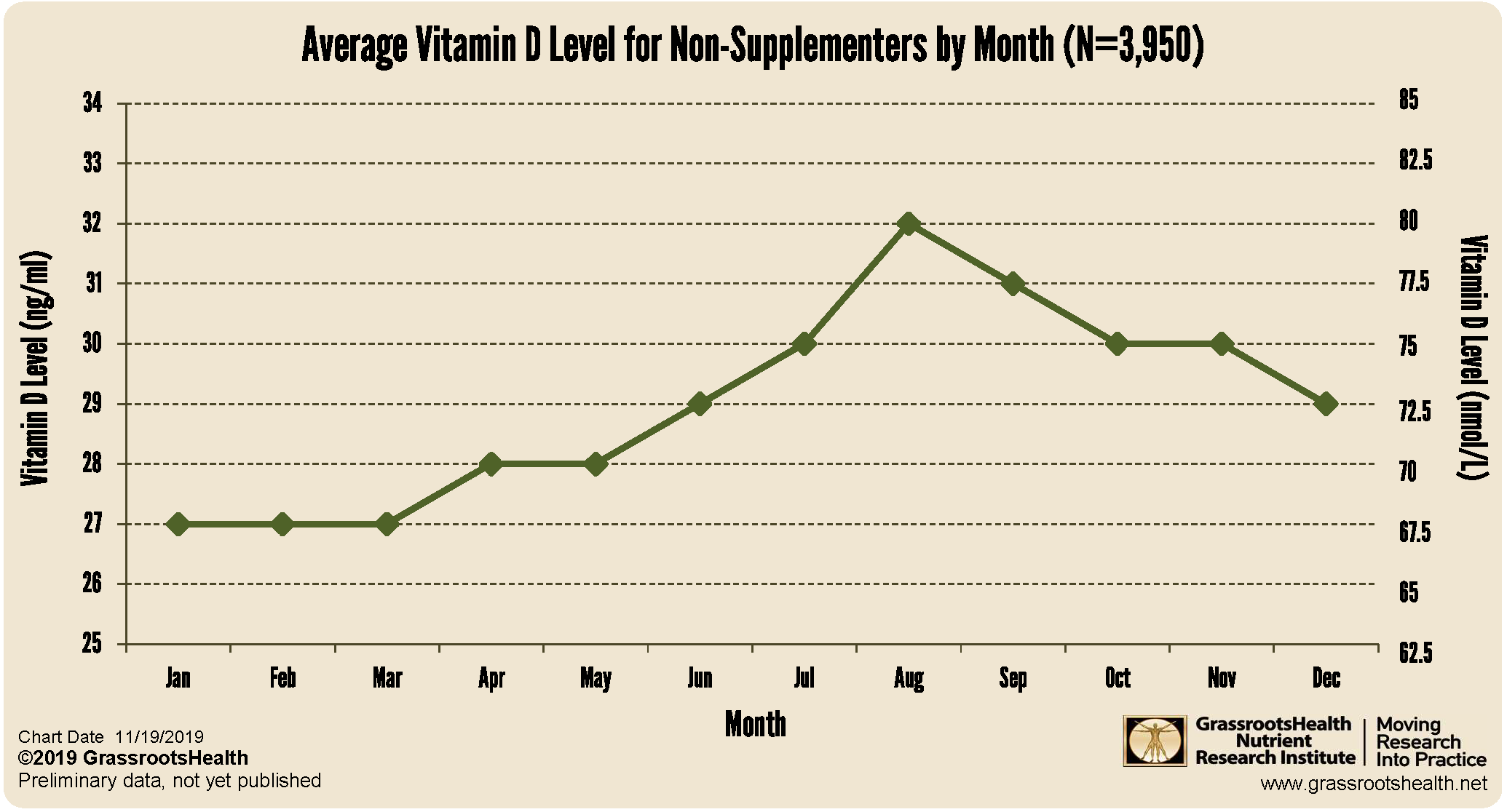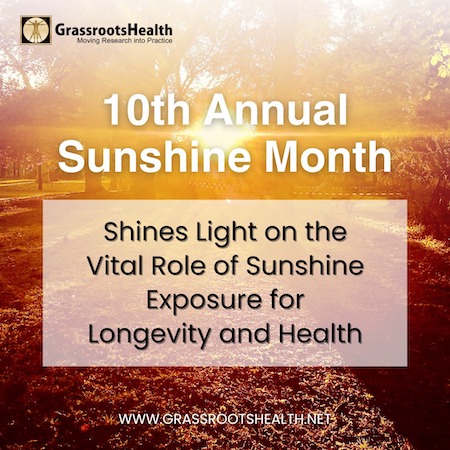Key Points
- GrassrootsHealth scientists recommend measuring the vitamin D level at the end of summer (September-October) and at the end of winter (March-April)
- Vitamin D levels peak in summer and begin to drop in September, according to a GrassrootsHealth cohort analysis
- The highest level reached for the year among those not supplementing averaged around 32 ng/ml (80 nmol/L)
- It is not uncommon for individuals relying on sun exposure for vitamin D to experience an unexpected dip in vitamin D level, making testing now a helpful step to avoid deficiency
 Vitamin D levels are known to vary markedly according to season, with levels peaking towards the end of summer and dipping at the end of winter. In an effort to maintain a target vitamin D level throughout the year [recommended as 40-60 ng/ml (100-150 nmol/L) by our panel of vitamin D scientists], GrassrootsHealth recommends measuring the vitamin D level at the end of summer (September-October) and at the end of winter (March-April), and adjusting your vitamin D routine to make up for what the change in seasons may bring.
Vitamin D levels are known to vary markedly according to season, with levels peaking towards the end of summer and dipping at the end of winter. In an effort to maintain a target vitamin D level throughout the year [recommended as 40-60 ng/ml (100-150 nmol/L) by our panel of vitamin D scientists], GrassrootsHealth recommends measuring the vitamin D level at the end of summer (September-October) and at the end of winter (March-April), and adjusting your vitamin D routine to make up for what the change in seasons may bring.
Where Did Your Vitamin D Level “Peak” This Summer?
While vitamin D levels usually peak at the end of summer, many of the GrassrootsHealth participants tend to rely more on sunshine exposure for their source of vitamin D during the summer months and will therefore decrease supplementation during that time. However, some work indoors throughout the summer and use sunscreen when out in the sun and must still rely on supplementation to maintain their target vitamin D level.
For those who do rely on the summer sun for vitamin D production, the change of season from summer to fall with decreased sun exposure leads to an increased need for supplementation. This can be tricky for some, and we often receive questions about an unexpected vitamin D test result during this transition – usually a level is lower than expected, which may be due to not increasing supplementation soon enough to maintain summer levels or having summer levels that were not as high as they expected.
As illustrated by the graph below, among almost 4,000 GrassrootsHealth participants who tested their vitamin D levels and reported that they did not take vitamin D supplements in the previous months, vitamin D levels peaked in the month of August and declined from there to their lowest levels during the winter months of January through March.
Was Your Summer Peak at Least 40 ng/ml?
While it is possible to reach a vitamin D level of 40-60 ng/ml through sunshine alone, the graph also shows us that the average vitamin D level reached at the peak was only 32 ng/ml (80 nmol/L).
With vitamin D levels beginning to drop in September, it is important to test before the fall months to get an accurate measurement of your peak level and to determine if action must be taken to help prevent levels from getting lower than you would like. Also, while GrassrootsHealth scientists recommend a vitamin D level between 40-60 ng/ml (100-150 nmol/L) as an optimal range, some individuals may choose to aim slightly higher for reasons such as cancer prevention or to help with auto-immune diseases.
Test Now to Plan Ahead for the Change in Seasons
Will you need more or less vitamin D intake from supplements? Will you be expecting more or less vitamin D from sun exposure? To help answer these questions for yourself, test your level now to determine if and how much vitamin D supplementation may be needed, or if other lifestyle changes (such as sunshine or indoor UVB) sould be implemented to help reach and maintain target levels year-round.
Remember to Check Important Co-Nutrients as Well
 Having and maintaining healthy vitamin D levels and other nutrient levels can help improve your health now and for your future. Choose which to measure, such as your vitamin D, omega-3s, and essential minerals including magnesium and zinc, by creating your custom home test kit today. Take steps to improve the status of each of these measurements to benefit your overall health. You can also track your own intakes, symptoms and results to see what works best for YOU.
Having and maintaining healthy vitamin D levels and other nutrient levels can help improve your health now and for your future. Choose which to measure, such as your vitamin D, omega-3s, and essential minerals including magnesium and zinc, by creating your custom home test kit today. Take steps to improve the status of each of these measurements to benefit your overall health. You can also track your own intakes, symptoms and results to see what works best for YOU.
Enroll and test your levels today, learn what steps to take to improve your status of vitamin D (see below) and other nutrients and blood markers, and take action! By enrolling in the GrassrootsHealth projects, you are not only contributing valuable information to everyone, you are also gaining knowledge about how you could improve your own health through measuring and tracking your nutrient status, and educating yourself on how to improve it.
Help everyone Move Research into Practice with vitamin D and other nutrients! As a special birthday gift to everyone, in honor of the science, we have created a special scholarship fund for anyone to donate to that will go towards helping others participate. Your donation will allow anyone to get help with funding their participation when they need it.



